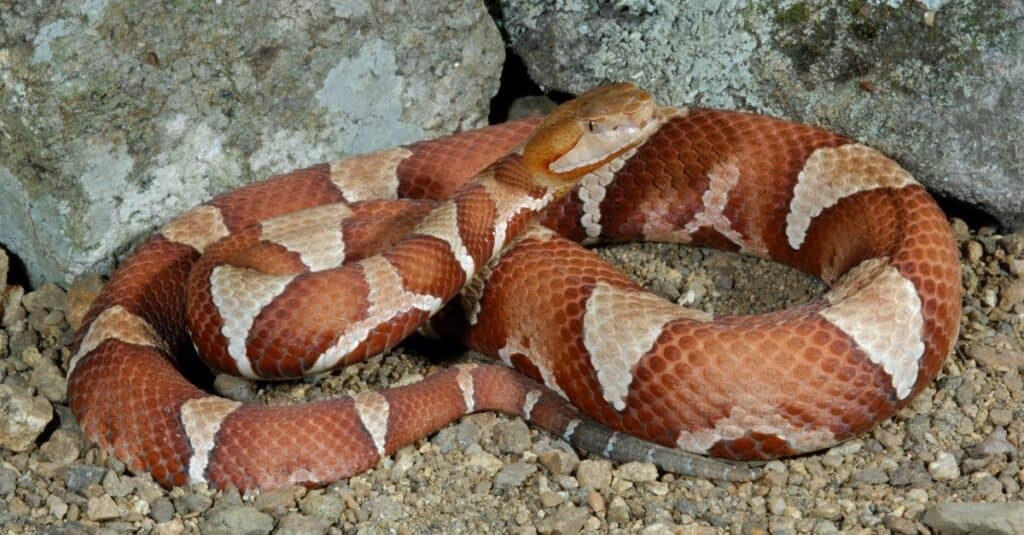Copperheads, like many other snakes, are highly venomous and dangerous. They tend to strike and bite, especially when accidentally touched or trampled. Copperheads are among the most common North American snakes, usually medium-sized, and are about 2-3 feet long.
The head of a copperhead is usually broad and copper-colored, while the lower or underside is typically pink in color. Copperheads are similar to other snakes, and knowledge about what they eat is an excellent way to differentiate them from others.
In this article, you will learn fascinating things about what exactly copperheads eat, how they eat, and how they find food in their habitats.
What Do Copperheads Eat?

Being predominantly carnivores, copperheads eat meat. Their diet largely depends on their current environment and the food present there. Copperheads are known to eat any animal that is small enough to be eaten, which is why they sometimes eat their young too.
Since copperheads food intake depends on their environment, in the wild, copperheads majorly eat mice, amphibians, and insects, depending on what they get. They eat cicadas too. As pets, copperheads are often fed with small mice, frogs, and lizards.
Below is a complete list of foods copperheads consume most times.
- Rats
- Mice
- Birds
- Snakes
- Swamp rabbits
- Lizards
- Frogs
- Toads
- Young Cottontails
- Young turtles
- Cicadas
- Grasshoppers
- Prairie voles
According to some studies in Kansas, even though it is well known that copperheads eat a lot of cicadas, it was found that they consume prairie voles more than cicadas. It was also discovered that baby copperheads don’t eat the same prey as adults. Most times, young copperheads eat insects, caterpillars, and smaller frogs, while the adults eat more mice and birds.
Additionally, copperheads eat about 1.25 to 2 times their body weight every season. Therefore, every year, they roughly consume about two times their body weight in preys. During the summer, copperheads can survive with just one meal every three weeks, and they can go all winter without eating anything.

Copperheads eat two times their body weight in a year
©Breck P. Kent/Shutterstock.com
What Animals are Copperheads’ Predators?
Copperheads are apex predators and are near the top of their food chain. They generally lay an ambush in search of their food. So, they hardly have natural predators, especially adult copperheads.
But in times of low resources, copperheads can, once in a while, become significant targets for other animals at the apex of the food chain too. Animals like owls, hawks, opossums, raccoons, and some other snakes can prey on them in times like this.
How Do Copperheads Hunt for Food?
Copperheads are majorly ambush predators in the sense that they wait patiently for their prey in a motionless manner to come within their range. They also possess heat-sensing pits around their face, between the eyes and nostrils, which helps them locate their prey after it is dead. This is the reason copperheads are referred to as pit vipers.
When copperheads spot their prey, they locate its precise position using their heat-sensing pits. They strike and inject venom into it, allowing them to escape knowing that their dangerous venom will kill the target. Copperheads trail their food until they find the now incapacitated or dead animal.
Copperheads come out depending on the season. During the spring and fall, they are usually out during the day searching for prey. But during the summer, they become nocturnal and operate most times at night. Their pits also help them in guiding their attack. The young copperheads possess yellow-tipped tails, usually to attract small prey like frogs.
Are Copperheads Dangerous to Humans?

Baby copperheads eat insects, caterpillars and very small frogs
©Jeff W. Jarrett/Shutterstock.com
Copperheads live comfortably in human environments. According to a publication by the National History Publication Series, copperheads are highly venomous snakes and members of the pit viper family.
Fortunately, a copperhead’s venom isn’t very dangerous to humans compared to the toxins from other snakes. Obviously, the bite is painful but is almost never fatal to humans. Only the tissues in the area bitten will be temporarily damaged. Urgent medical help will salvage the situation.
The bite of copperheads can only be a threat to people who have issues with their immune systems. But one thing to note about copperheads is that they are lethargic and don’t strike and bite unless they are disturbed. Therefore, once copperheads sense any disturbance that looks like danger, they attack immediately without warning.
Will Cicadas Attract More Copperheads to an Environment?
It is a known fact that Copperheads tend to consume cicadas more than other foods. Usually, cicadas spring out from foliage and trees, especially during the summer periods.
An exciting thing about cicadas is that they shed their skin after some time, and copperheads, when they prey on them, usually feed on their skins alongside them. In shedding their skin, they are often motionless, which makes it possible for copperheads to prey on them with ease and with enough feeding time.
Cicadas can’t attract copperheads to areas they have dominated. But instead, the copperheads that tend to feed on them are those that exist in that area already.
Discover the "Monster" Snake 5X Bigger than an Anaconda
Every day A-Z Animals sends out some of the most incredible facts in the world from our free newsletter. Want to discover the 10 most beautiful snakes in the world, a "snake island" where you're never more than 3 feet from danger, or a "monster" snake 5X larger than an anaconda? Then sign up right now and you'll start receiving our daily newsletter absolutely free.
Thank you for reading! Have some feedback for us? Contact the AZ Animals editorial team.








